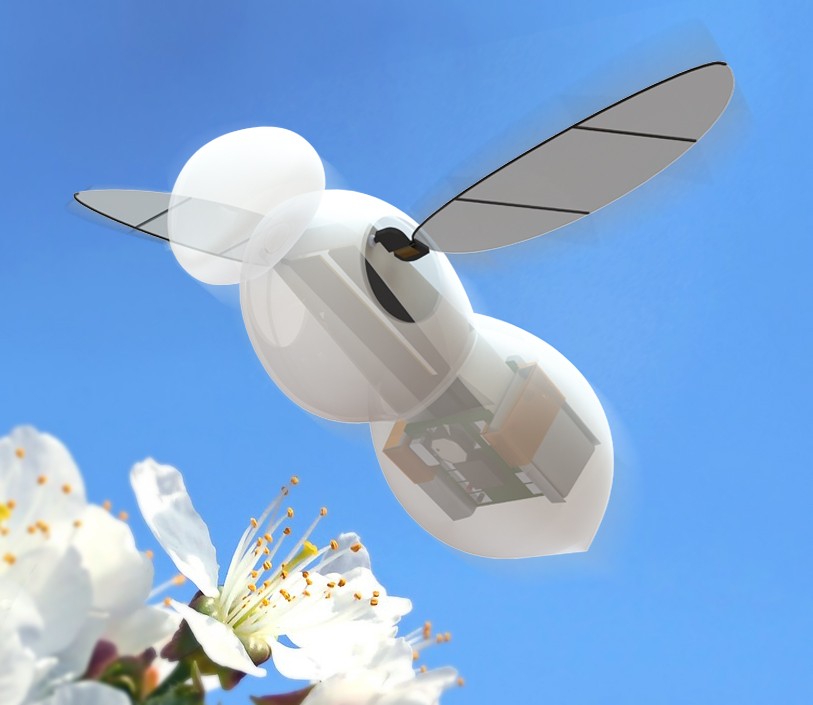Developing Artificial Bees to Replace the Real Thing
As global bee populations decline, researchers at Manchester University are creating tiny, agile “microrobots” that can fly and jump like bees and spiders, and could potentially replace the real thing.
May 18, 2018

|
Manchester University researchers believe microbots that mimic the behavior of bees could potentially take over for their real life counterparts as global bee populations dwindle. (Image source: University of Manchester) |
“Smaller is stronger,” according to Dr. Mostafa Nabawy, an aerospace engineer at Manchester University. Nabawy has been exploring just how small a self-propelled flying machine can be. In his microsystems lab, Nabawy has built prototypes of artificial bees, weighing as little as 1.5 grams, including the battery. The goal is to make a robotic bee that can fly independently, under control, for an extended period of time.
Yes, it sounds like something straight out of an episode of Black Mirror. But according to United Nations reports, bee populations are declining globally due to a variety of factors including pesticide use, invasive species, diseases, and climate change. With recent declines in pollinator populations, artificial bees could offer a substitute as effective as living pollinators and will not succumb to chemical pesticides.
“We started learning from flying insects, in terms of the aerodynamics of the wings, their shapes, how they move them, and how the different shapes generate forces,” Nabawy told Design News. “The problem with [wing] flapping at this tiny scale is that it is very energy-demanding, so power sources become a big problem for us.”
The Manchester University lab has conducted exhaustive studies on tiny actuators, including piezoelectric, DC motors, and other hybrid actuators. By testing the artificial bees by constraining them in space and measuring forces, Nabawy found that the actuator could provide enough force to move the wings, and the battery enough energy to keep it operating for up to five minutes.
RELATED ARTICLES:
On the question of whether propellers with fixed wings are more efficient than flapping wings, Nabawy acknowledges that they can be, depending on operating conditions. But efficiency isn’t everything. Other characteristics could be quite valuable in a tiny flying robot. In an interview with New Scientist, Nabawy explained that the presence of leading-edge vortices on the wings of bees, “mean the wing can fly at a much higher angle of attack without stalling.” This allows for more maneuverability, the ability to fly at slower speeds, and hovering.
Insects have been a fascination for engineers since the '90s, when the move toward miniaturization really took off. Their maneuverability and ability to control their direction even under strong wind conditions have been recognized as being complex and impressive. Nabawy spent the earlier part of his career designing conventional aircraft, but eventually found himself working on “insect-like robots” as he became interested in “how things operate in nature.”
Nabawy’s microsystems lab is not only interested in bees, but in the larger field of “bio-inspired microrobots.” In addition to flying robots, the lab is also looking at tiny machines that can jump, for example. To that end, they have studied the jumping performance of Phidippus regius—the jumping spider. “Jumping spiders jump for predation, which makes them far more accurate than other insects,” Nabawy explained. And while their jumping distance is not spectacular, at 6-8 body lengths from a standing start, it certainly exceeds the human ability, which is around 1.5 body lengths. What impresses Nabawy most about these spiders is their sophisticated “motion planning” ability. Depending on the situation, jumping spiders will either optimize for speed or distance. Nabawy hopes to emulate this in microrobots some day.
Nabawy said that jumping microrobots could be used for agricultural pest control as an alternative to chemicals. The jumping ability could also be viewed as a subordinate goal to that of a highly versatile microrobot with the combined ability to walk, jump, and fly. Nabawy and his colleagues recently published research around their work with jumping spiders in the journal Scientific Reports.
Certainly, the utility of such a device in a military or surveillance application is not hard to imagine. No doubt, many other applications will emerge as the technology evolves.
Machester University also released a video discussing the microrobotics research involving jumping spiders:
RP Siegel, PE, has a master's degree in mechanical engineering and worked for 20 years in R&D at Xerox Corp. An inventor with 50 patents, and now a full-time writer, RP finds his primary interest at the intersection of technology and society. His work has appeared in multiple consumer and industry outlets, and he also co-authored the eco-thriller Vapor Trails.
|
About the Author(s)
You May Also Like





